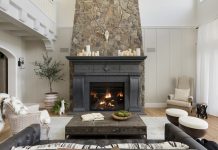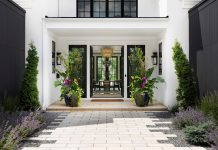Photos by Bernadette Fox

In 2013, a family member’s Lakeville basement became the birthplace of Zach Dutton and Thomas Brown’s contemporary light fixtures. From an in-home operation to the Etsy online marketplace to a full-fledged showroom offering in-person appointments tailored to each client, Dutton Brown Design is still growing—particularly after landing a Room & Board lighting collaboration and expanding into product lines of hardware and pillows. Plus, they already know the Minneapolis building they bought at the end of 2019 (their third facility upgrade) will need expanding.
Color has always been king at Dutton Brown, where fixtures come in a rainbow of finishes and hues to match everyone’s space and personality. Signatures of the brand include the Sputnik chandeliers, and the pair has countless sketches just waiting to become reality. To add to the bustle, they’re launching another collaboration with Room & Board this spring that will focus on hardware. Before they got too busy, we stole a few minutes with the pair to talk materials, visualization, and, of course, color.

How do you choose the colors for your light fixtures?
Brown: We honestly started more with primary colors earlier on. As we grew, we’ve been getting more requests: Can you do this color? Can you do this color? So, it’s a mix of those requests and also what we’ve seen to be on trend.
Dutton: We also take it a step further. You can pay a customization fee, and we can match any color with exactly what you need.
Any advice to help people visualize the lights in their own space?
Brown: We encourage samples as the best way to see a color, and it’s best to take them to the space where they will be used. If you bought a bright color, maybe a Kelly green, and you put it in a window, it’s beautiful. But then at night with no light, when you turn it on, it’ll dull the color a bit. Samples are all about managing expectations in-situ.
Dutton: We offer SketchUp (a 3D-modeling computer program) and any tools you need to envision something in your space. Also, there are tons of customer pictures [to look at] and pictures that we either Photoshopped or staged in real life.
What’s one engineering challenge you’ve worked through?
Brown: Making acrylic appear crystal-clear. With other brands, sometimes it’s a little cloudy; sometimes there are small micro scratches. We are very adamant to make sure they are fire-polished and have clarity. We want someone to take it out of the box and say, “Wow.”
 Which product is your favorite?
Which product is your favorite?
Dutton: For me, it’s kind of like a favorite song. When your favorite artist comes out with a new song, you just love it. The newest is always my favorite.
Brown: Right now, we’re working with aluminum parts. They give us more capabilities to make modern shapes. A sconce called Icon and chandelier called Commander are aluminum fixtures—which allows them to be light—but we can also do so much to the shape.
New materials, movement—All this, and color is still your focus?
Brown: These other items are just necessary, like the ability to move something—yes, that’s something that anybody should be able to do. The ability to use high-quality parts, different materials—that’s the same thing. But what we feel is really special about us is our ability to offer an integrated system of color. We do so much lighting, so one thing people often ask us is why we don’t call it a lighting company. It’s because we never intended to solely be one. Hardware is just our first foray into our promissory to become a colorful home décor company.
























